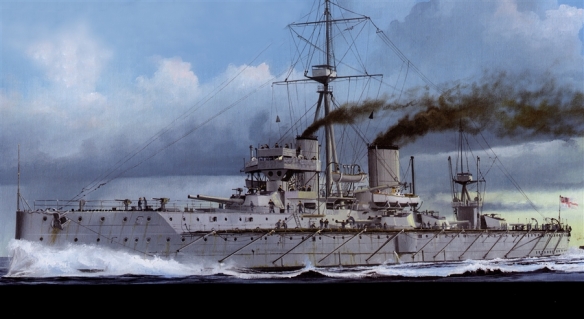All-big-gun designs commenced almost simultaneously in three navies. The Imperial Japanese Navy authorized the construction of Satsuma, designed with twelve 12-inch (305 mm) guns in 1904; she was laid down in May. The Royal Navy began the design of HMS Dreadnought in January 1905; she was laid down in October. The U.S. Navy gained authorization for USS Michigan, carrying eight 12-inch guns in March; she was laid down in December 1906.
The move to all-big-gun designs was accomplished because a uniform, heavy-caliber armament offered advantages in both firepower and fire control, and the Russo-Japanese War showed that naval battles could, and likely would, be fought at long distances. The newest 12-inch (305 mm) guns had more long-range firepower than a gun of 10-inch (254 mm) or 9.2-inch (234 mm) caliber. Most historians also cite advantages in fire control; at long ranges guns were aimed by observing the splashes caused by shells fired in salvos, and it was difficult to interpret different splashes caused by different calibers of gun. There is still debate as to whether this point was important.
The Royal Navy had to accelerate Dreadnought’s construction, knowing full well that the other major naval powers had their own dreadnought-type battleships on the drawing boards. In fact, the Japanese Satsuma class (laid down in 1903, completed in 1909) should be credited as the world’s first all-big gun battleships laid down. Plans for the U. S. Navy’s dreadnought-type battleships, the South Carolina class (laid down in 1905, completed in 1910) had also been drawn up before Dreadnought. The naval powers had come to realize that smaller-caliber guns on battleships led to confusion in gunnery spotting during battle, that mixed-caliber projectiles complicated handling, and that a single heavy gun size would simplify matters across the board. In sum, Dreadnought set the pattern for the 177 dreadnought-type warships subsequently laid down by the world’s navies between 1905 and 1941 (this figure includes uncompleted battleships).
Dreadnought embodied several significant technological advantages already enjoyed by the Royal Navy. The first was its heavy 12-inch and later 13.5-inch and 15-inch guns, with their greater hitting power and their flatter trajectories-that is, when their shells performed as designed. The second was Dreadnought’s faster turn of speed.
The greatest single undisputed Royal Navy superiority lay in its dreadnoughts’ turbines, pioneered by Dreadnought itself. At the time, no large steam turbine-powered ship had even been laid down, and the first RN turbine-propelled destroyers had been at sea only for four years. Turbines, lighter and more compact than reciprocating engines, gave Dreadnought a 2-knot advantage over its closest contemporaries; they were also more durable. Great Britain was so far ahead in turbine manufacturing, in fact, that for years afterward even advanced maritime powers such as the United States, Italy, Japan, and Germany had to build turbines under licenses from British firms. The United States did not go over to its own domestic turbines (Curtis) until the Nevadas (laid down in 1912). The Italians installed the Parsons turbine drive for their first dreadnought (Dante Alighieri, laid down in 1909) and did not install a domestically manufactured turbine (from Bulluzo) until the Littorio class (laid down in 1934-1938). The French stuck with Parsons turbines (with one mixed-drive exception) through to the end of their battleship construction. The first German turbine-powered battleships, the Kaiser class, were not even laid down until almost five years after Dreadnought. (This fact alone should invalidate much of the popular assertions of German technological superiority, spread as much by British journalists as by the Germans.)
The U. S. Navy, full of imperial visions in the wake of the triumphant Spanish-American War, had every expectation of soon surpassing the size and strength of the Royal Navy. As it was, the U. S. Navy trumped Dreadnought with its new South Carolina class (South Carolina and Michigan, completed in 1910) by arranging all of their heavy guns line-ahead, one turret mounted over another, a design pattern that all dreadnoughts would follow. The British and the Germans persisted in mounting wing turrets until the former’s Orions, laid down in 1909, and the latter’s Koenigs, laid down in 1911. But the U. S. designers hesitated to install turbines, so the South Carolinas had a speed some three knots slower than Dreadnought. The South Carolinas thus were not deployed to European waters during World War I and, in some circles, were not even considered to be dreadnoughts. At any rate, the Americans built their battleships for long range and protection, sacrificing some speed in the process.
